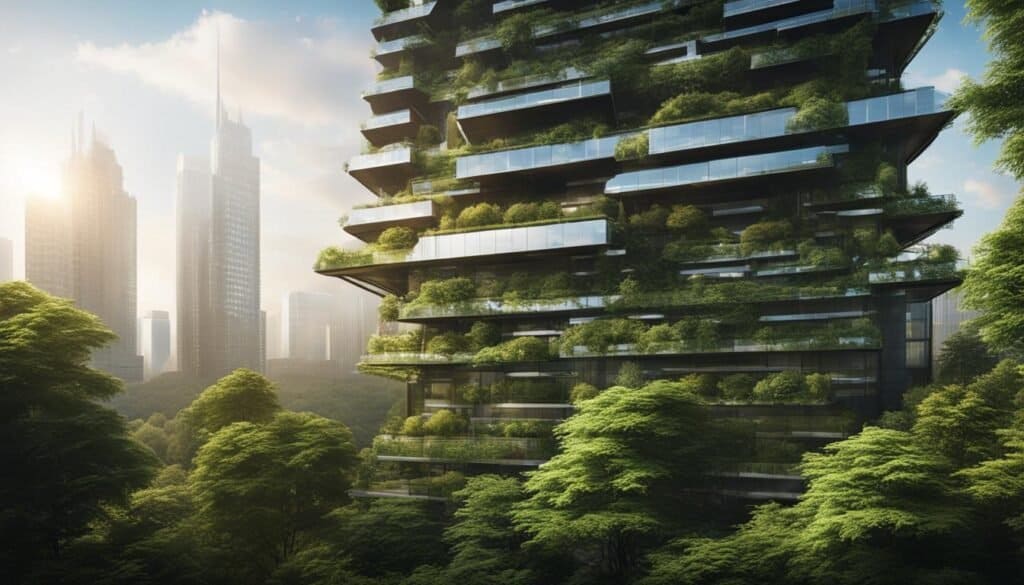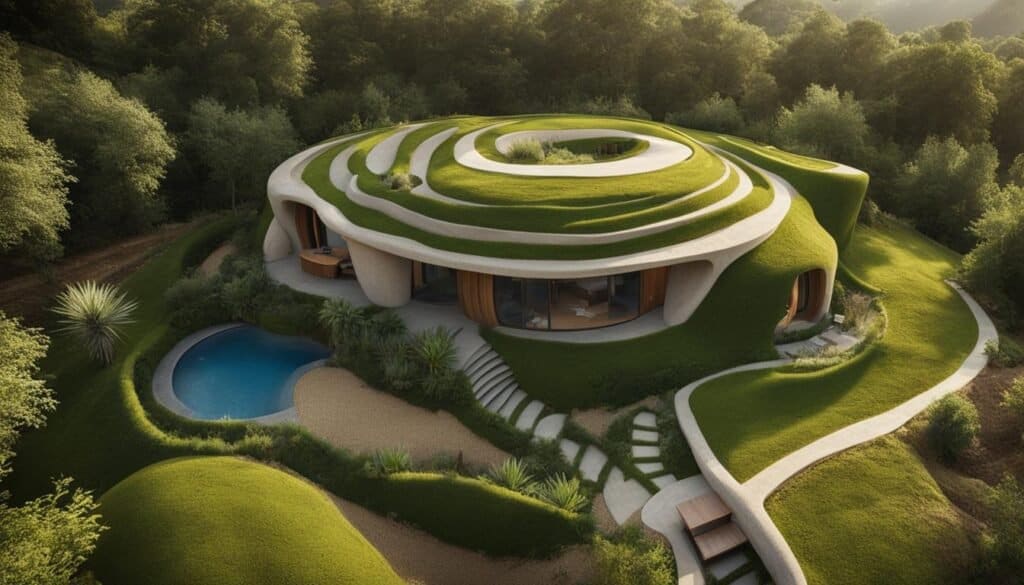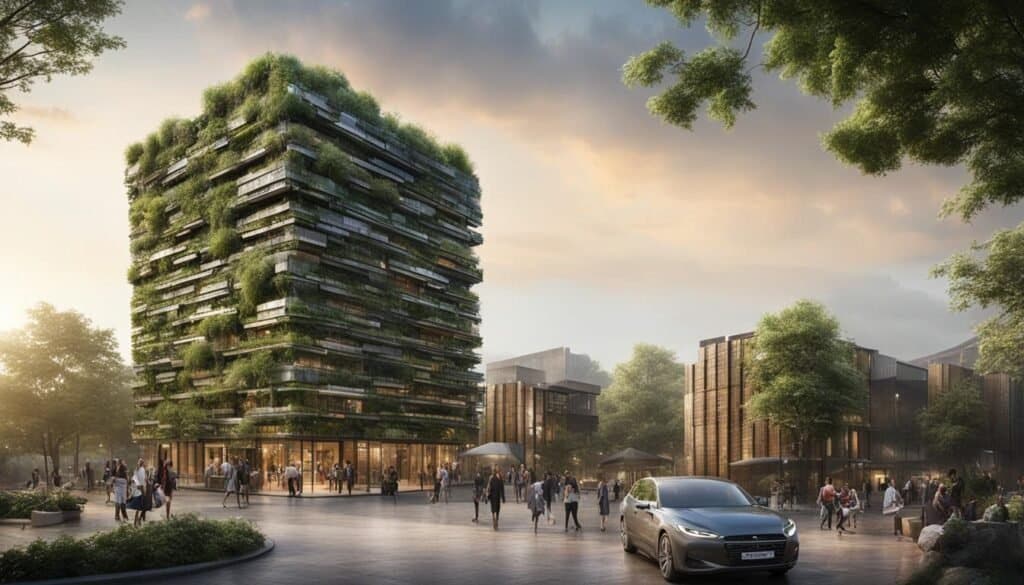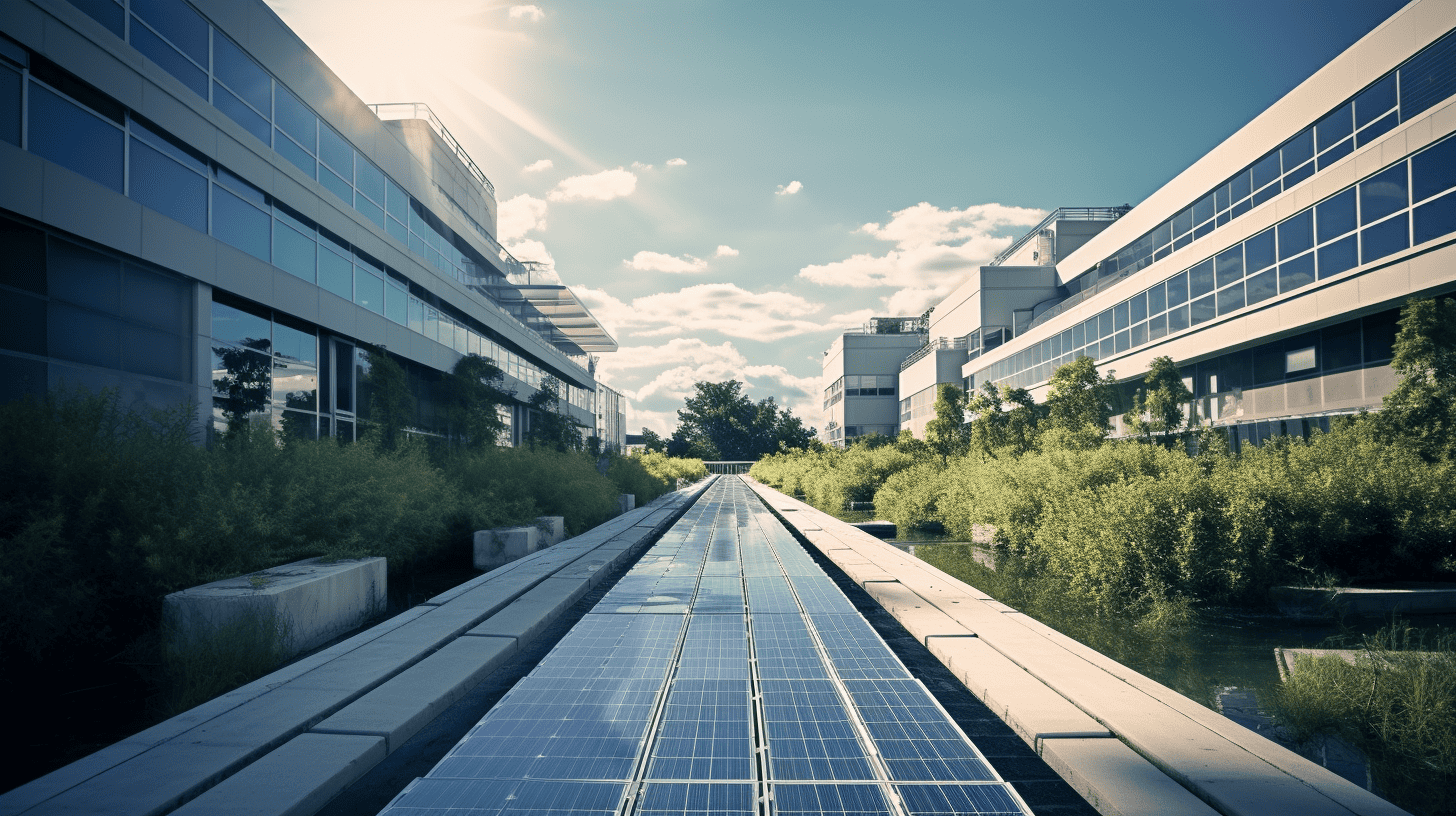The urgency of eco-friendly materials compels us to embrace techniques that support sustainable living in name and ethos. Whether drawn to humble solutions like straw bale insulation or innovating net-zero emissions designs, the potential of environmental architecture invites rethinking infrastructure.
Building with the lightest planetary touch must guide every nail we drive if we seek to construct truly sustainable spaces for future generations. The time has come to explore materials shaping the future of green buildings.
Key Takeaways
- Sustainable building materials are integral to eco-friendly construction and reducing greenhouse gas emissions.
- From cob to recycled plastic, the choice of green material impacts energy use and overall environmental health.
- Adopting sustainable construction practices involves a lifetime approach, considering the complete lifecycle of building materials.
- Through the lens of sustainability, even traditional raw materials, such as sheep’s wool, offer innovative, eco-friendly solutions.
- Green building conserves natural resources and nurtures the built environment for future generations.
- Environmentally responsible building is achieved by selecting durable and sustainable materials.
The Imperative Shift Towards Sustainable Building Materials
In my commitment to safeguarding our environment, I have always promoted eco-friendly building materials that prioritize sustainability at every phase of their life cycle. The construction sector, recognizing its critical role in our planet’s environmental health, is witnessing a momentous shift towards materials that offer energy efficiency, reduce emissions, and leverage the benefits of a sustainable manufacturing process.
Witnessing states like California taking the helm in pioneering green home construction brings me a sense of fulfillment. Californians are embracing sustainable alternatives that not only help tackle climate change but also champion the conservation of our precious natural resources. The transition to materials that can be recycled and have minimal environmental impact represents a profound change in industry standards—ones that are compatible with creating a sustainable society.
Livingetc: Bamboo is an ideal renewable resource for eco-friendly furnishings, as it grows quickly and can be easily replaced, contributing to more planet-friendly designs.
Understanding and utilizing the entire life cycle of building materials can significantly diminish our living spaces’ ecological footprint. Through my in-depth knowledge and engagement with the industry, I’ve seen how materials like rammed earth, adobe, and cob are not only an homage to ancient wisdom but also formidable sustainable alternatives in today’s construction landscape.
Implementing eco-friendly building practices isn’t just beneficial for the environment; it’s a long-term investment in the health and sustainability of our communities.
Creating a green home extends beyond the mere structure—it encapsulates a holistic approach that includes resource efficiency, waste reduction, and a thoughtful balance with the natural world. Let’s examine how certain materials exemplify this approach:
| Eco-Friendly Material | Recyclability | Energy Efficiency | Environmental Impact |
|---|---|---|---|
| Rammed Earth | High (Locally sourced) | Excellent (Thermal mass) | Low (Uses natural earth) |
| Adobe | High (Biodegradable) | Good (Thermal properties) | Low (Made from raw earth) |
| Cob | High (Biodegradable, compostable) | Excellent (Natural insulation) | Minimal (No emissions or pollutants) |
| Recycled Steel | Very High (Can be recycled indefinitely) | Good (Retains strength) | Reduced (Less energy than producing new steel) |
Efforts to move away from materials that contribute heavily to landfill accumulation and emissions during production are ramping up. The materials tabled above not only stand out in performance but also paint a picture of a future where each building contributes positively to the environment—where the mantra “reduce, reuse, recycle” is no longer an afterthought but a fundamental pillar of the design and construction process.
We can no longer afford the high cost of short-sighted building practices. Eco-friendly material options and sustainable manufacturing processes are no longer the fringe—they are the foundation of tomorrow’s responsible and progressive building industry.
Bamboo: A Renewable Marvel in Green Construction

I have uncovered the remarkable potential of bamboo as a green building material. Renowned for its quick-growth cycle, bamboo is a beacon of renewable versatility in eco-friendly construction. A mere 3-5 years is all this plant needs to mature, a stark contrast to the decades required by traditional hardwoods. Its inherent biodegradable qualities, once harvested, if left untreated, demonstrate a profound respect for our planet’s biological cycles.
As a proponent of green construction, I see bamboo as more than just a material; it represents a philosophy for harmonious living with nature. Its adoption in construction circles is an act of environmental stewardship, setting a precedent for future building practices.
Quick-Growth Cycle and Biodegradable Qualities
My fascination with bamboo’s sustainability is amplified by its regenerative nature. Not only does it reach maturity rapidly, it does so with minimal environmental impact. The quick-growth characteristic of bamboo enables continuous harvesting without deforestation, ensuring a reliable supply of biodegradable and sustainable building materials for many construction applications.
But let’s not overlook another attribute – its biodegradability. Bamboo’s life cycle concludes by returning to the earth, contributing to the universal cycle of growth and decay. This is as eco-conscious as it gets, where the material used for our homes and buildings can one day decompose without harming the environment.
Bamboo in Structural Applications and Aesthetics
The strength of bamboo resides in its fibers, running axially from root to tip, lending an incredible tenacity that rivals many traditional materials. This quality is instrumental when bamboo is utilized in green building material implementations for structural purposes. Its robustness can support skyscrapers, providing a persistent backbone that encapsulates both eco-friendliness and durability.
The Zebra: Utilizing green building materials like mushrooms, old tires, and straw in sustainable architecture not only lowers energy bills but can also reduce home insurance costs, making them efficient and eco-friendly choices
Elegance is yet another facet of bamboo, a gift that it lends naturally to buildings. As an architect with a keen eye for sustainable aesthetics, I’ve observed bamboo’s ability to impart a serene and organic ambiance to any structure. Its unique texture and warm hues contribute to the dialogue between the building and its surroundings, emphasizing a narrative of environmental consonance.
| Aspect | Benefits of Bamboo |
|---|---|
| Growth Rate | Harvest-ready in 3-5 years, ensuring sustainable production |
| Strength | Comparable to steel, allows for resilient building structures |
| Ecological Impact | Biodegradable and renewable, reducing carbon footprint |
| Design Versatility | Aesthetic appeal blends with diverse architectural styles |
Let us then embrace bamboo for its environmental efficacy and role in sculpting a future where our structures echo the principles of ecological mindfulness.
Reclaimed and Recycled Wood: Giving New Life to Old Materials
In my continued advocacy for eco-friendly building, the profound value of reclaimed and recycled wood cannot be overstated. Harnessing this sustainable wood is more than just a creative endeavor; it’s a testament to the tenets of upcycling and reuse, pivotal in advancing green construction materials. By integrating such woods into the framework of a home, we not only diminish energy use but also enrich our living spaces with natural, warming elements that resonate with our innate affinity for nature.
It bridges a gap between past and present, infusing contemporary buildings with history and character. Through upcycling methods, where old materials are given new purpose, I’ve observed how the marriage of functionality and aesthetics is seamlessly achieved. Exposed beams from reclaimed wood bring an organic touch to modern architecture, whereas recycled wood flooring conjures a rustic charm within an urban context.
Whether reclaimed from antiquated barns or salvaged from long-standing structures, every plank tells a story, enriching our eco-friendly living spaces with a tapestry of historical reverence.
The mantra ‘reduce, reuse, and recycle’ is beautifully embodied by sustainable wood use in green construction material. Sourcing from sustainable forests ensures each timber piece’s continuity in the circular construction economy, thus contributing massively to eco-friendly building. The chart below details the impact and utility of reclaimed and recycled wood, unequivocally illustrating its embodiment of green principles.
| Material Type | Reclaimed Wood | Recycled Wood |
|---|---|---|
| Source | Historical structures, old furnishings, discarded beams | Manufacturing scraps, post-consumer wood products |
| Energy Use in Processing | Minimal, primarily due to refinishing and reshaping | Lessens environmental impact supports sustainable building practices |
| Benefits in Construction | Equal or more significant than new wood, depending on original quality | Lessens environmental impact, supports sustainable building practices |
| Longevity of Use | Equal or more significant than new wood, depending on the original quality | Varies with the quality of recycled material and the thoroughness of the recycling process |
Engaging with a construction material encapsulating beauty, durability, and a respectful nod to conservation and sustainability is heartening. The intrinsic value of these materials transcends mere aesthetics, weaving utility and ecological awareness into the very fiber of our homes and buildings.
Living in harmony with our environment entails a conscious selection of materials and a dedication to recycling and upcycling that can lower our carbon footprint. In choosing reclaimed and recycled wood for our structures, we actuate the full potential of these sustainable materials, fostering eco-friendly building and crafting legacies for future generations.
Recycled Steel: The Enduring Backbone of Eco-Friendly Structures

In my professional journey, I’ve recognized recycled steel as a pivotal engineering marvel in constructing eco-friendly structures. The very essence of this material is synonymous with durability and resilience, attributes imperative to modern architecture. Strength retention plays a crucial part in the longevity and robustness of these constructions, making recycled steel a formidable contender against more traditional materials.
Recycled steel redefines the concept of strength retention, standing as a testament to how industrial robustness and environmental mindfulness can coalesce.
Not only does this stalwart material bolster the safety and integrity of a building, but it also champions energy conservation. Recycling steel demands a fraction of the energy compared to manufacturing virgin steel, illuminating the path to low-energy manufacturing and reducing our carbon footprint. This pathway aligns with my ethos and mirrors the construction industry’s shift towards sustainability.
Strength Retention and Energy Conservation in Recycling Steel
The act of recycling does not compromise the innate fortitude of steel. This is a material where strength and sustainability are inextricably linked, ensuring that each reincarnation as a beam or a column fortifies our belief in the potential of sustainable steel use. The table below showcases the formidable interplay between energy conservation and strength retention in the sustainable lifecycle of recycled steel:
| Property | Description | Benefit |
|---|---|---|
| Strength Retention | Retains structural integrity after numerous recycling processes | Ensures longevity and safety of eco-friendly structures |
| Energy Conservation | Requires less energy than producing new steel | Contributes to sustainability and green building initiatives |
| Low-Energy Manufacturing | Diminished energy usage in the steel recycling process | Reduces emissions, promoting a cleaner environment |
| Environmental Responsibility | Diverts waste from landfills, reduces need for mining | Advances circular economy principles within the building sector |
As we delve deeper into the nuances of green building materials, I recognize the profound impact that recycled steel has already begun to imprint on our urban landscapes. With a renewed sense of purpose, I advocate continuing this trend towards incorporating recycled materials in construction, heralding a future reflective of strength and sustainable practice.
The use of recycled steel in construction not only upholds the integrity of our buildings but also enshrines the ideals of eco-friendly and sustainable living. In every steel beam that reinforces a structure, I see an opportunity for industry-wide transformation—one where each construction element serves as a cog in the machinery of environmental conservation.
Rammed Earth: Foundations Rooted in Sustainability

Reflecting on the transformative power of natural materials in architecture, I admire the exemplary rammed earth. This method epitomizes a sustainable foundation by merging the raw, unrefined splendor of the earth with contemporary building techniques. There’s something profoundly grounding about forming a home from the soil it stands—each layer of compacted earth telling a story of ecological awareness and architectural resilience.
In the spirit of green building, rammed earth serves as both structure and statement, its essence rooted in the tradition of living in harmony with the environment. The virtues of rammed earth stem from its composition and harmony with passive solar design, creating energy-efficient homes that resonate with both antiquity and modernity.
I’ve come to understand that in the realm of green architecture, few materials speak to the ideals of sustainable living as eloquently as rammed earth—each wall is a testament to both the past and the future of sustainable construction.
Consider the inherent beauty that exudes from the simplicity of its components—clay, gravel, and sand, all elements that require minimal processing and can be sourced directly from the construction site or nearby locales. The reduction in transportation emissions linked to material sourcing is another facet of rammed earth that aligns with my vision for sustainable building practices.
Once erected, the thermal mass of a rammed earth wall works in concert with the sun’s natural path, absorbing heat during the day and releasing it as temperatures dip. This passive regulation of indoor climate is not just a technique derived from across the centuries but an essential principle in energy-efficient homes.
Here is a comparative table that illustrates the sustainability factors of rammed earth construction:
| Sustainability Factor | Benefit |
|---|---|
| Material Source | Locally sourced, minimal environmental disturbance |
| Energy Footprint | Reduces construction and life cycle energy demands |
| Longevity and Maintenance | Highly durable, low maintenance needs over time |
| Climate Control | Exceptional thermal mass, contributing to passive cooling and heating |
| Aesthetic Quality | Natural, earthen allure with minimalistic elegance |
| Reduction in Emissions | Less transport lower carbon emissions during the construction phase |
By crafting structures from rammed earth, we tap into an enduring tradition and advance a modern, sustainable foundation and construction methodology. It’s a holistic approach that merges the philosophies of green building with practical applications to forge life space environments that are both energy-conscious and beautifully robust.
Cob Construction: Molding the Future with Ancient Techniques

As I delve deeper into sustainable construction, my attention is captivated by cob construction’s revival, embodying sustainability principles rooted in ancient building techniques. This time-honored material, composed of an accessible mix of subsoil, water, straw, and occasionally lime, brings forth eco-conscious living from the grounds of history to the thresholds of modernity.
Featuring a tactile and organic texture, cob construction facilitates a realm of creative flexibility that is seldom paralleled by contemporary materials. The moldability of cob lends itself to the whimsical creation of unique, fluid forms that celebrate artistic expression and functional efficacy. It’s not just a building practice; it’s an art form that allows nature and nurture to converge on the architectural canvas.
Eco-friendly building is more than a practice; it’s a belief in the possibility of low-impact living. In my exploration of materials championing this belief, cob stands out for its intrinsically energy-efficient qualities. Homes built with this earthy substance boast superior insulation, translating into substantial energy savings, especially in domestic heating spaces.
Cob’s Energy Efficiency and Creative Flexibility
In my journey to promote eco-friendly building, I’ve come to regard the inherent thermal properties of cob as a cornerstone for energy-efficient homes. Its bulk density affords a thermal mass that naturally regulates indoor temperatures, capturing warmth during colder months and maintaining coolness in the heat of summer.
Embracing cob is embracing a legacy of harmony with the environment. Structures crafted from this ancestral mixture do not merely stand; they breathe, creating a living testament to eco-friendly values.
Cob’s adaptability allows it to be sculpted into virtually any shape or design, fostering environments that resonate with the individuality of their inhabitants. This creative latitude empowers architects and builders to tailor spaces as unique as those they serve.
Here’s a glimpse into how cob’s attributes align with the principles of sustainable construction:
| Attribute | Description | Contribution to Sustainability |
|---|---|---|
| Natural Insulation | Cob provides excellent thermal resistance. | Minimizes the need for mechanical heating and cooling. |
| Low Environmental Impact | Made from abundant, natural materials with minimal processing. | Reduces emissions associated with manufacturing and transportation. |
| Recyclable | Components can be rehydrated and reused, or safely returned to the earth. | Sustains the environment by avoiding waste generation. |
| Embodied Energy | Requires relatively little energy in its creation and application. | Contributes to overall energy efficiency from a lifecycle perspective. |
The future of sustainable construction beckons us to blend past knowledge with contemporary insights, and cob construction stands as a fulcrum in this evolutionary journey. I firmly advocate for its broader integration into modern building practices, convinced that this earth-born material can sculpt resilient structures and an equally resilient planet.
Sheep’s Wool Insulation: Harnessing the Cozy and Eco-Friendly Fibers

In examining the burgeoning trends of green building, I have been particularly taken by sheep’s wool insulation. This natural insulation material is a nod to ancestral wisdom and a cutting-edge solution for today’s environmental and energy challenges. Sheep’s wool, often associated with comfort and warmth in clothing, has found an innovative application as an energy-saving material in constructing homes and buildings.
Within the labyrinth of each wool fiber, an army of tiny air pockets stands guard, providing formidable thermal resistance and encapsulating warmth.
These unique properties of sheep’s wool make it an exemplary choice for those prioritizing eco-friendly fibers in their construction projects. In the internal cavities of walls, nestled snugly in the ceilings, or lying unobtrusively in attics, sheep’s wool performs its role silently yet effectively, reducing our carbon footprint and contributing to a more sustainable habitat.
Energy efficiency is not an abstract concept when it comes to eco-friendly construction practices. It is a tangible asset, one that sheep’s wool embodies. This remarkable material offers the following advantages:
- Renewability: Wool is readily produced yearly by sheep, providing an ongoing source of environmentally friendly material.
- Superior Insulation: The natural crimp of sheep’s wool fiber creates insulating air spaces that enhance energy efficiency.
- Humidity Regulation: Wool insulation can absorb and release moisture and maintain a comfortable indoor atmosphere.
- Sound Absorption: Wool inherently reduces sound transmission due to its dense fibrous structure.
- Fire Resistance: Wool’s high nitrogen and water content renders it naturally flame-retardant.
- Low Impact: Harvesting wool is a low-energy process, reducing the environmental burden associated with production.
Here’s a comparative table that presents the properties of sheep’s wool insulation beside other common insulating materials:
| Insulation Material | Thermal Conductivity | Moisture Regulation | Fire Resistance | Eco-friendliness |
|---|---|---|---|---|
| Sheep’s Wool | Low | Excellent | High | Outstanding |
| Fiberglass | Low | Poor | Moderate | Low |
| Cellulose | Low | Good | Low to Moderate | High |
| Polystyrene | Low | Poor | Poor | Very Low |
Green building champions can use sheep’s wool to create structures that speak to the heart of environmental stewardship. It is a marvelous alignment of old-world resourcefulness with the sustainability aspirations of the modern world.
The architectural choices we make today echo into the future, and through my commitment to sustainable practices, I continue to herald materials like sheep’s wool as not only practical but profoundly eco-driven options. Whether as part of a new build or retrofitting an existing structure, the insulation provided by these eco-friendly fibers contributes significantly to an edifice that is as energy-conscious as it is resilient.
Recycled Plastic: Transforming Waste into Durable Construction Materials

In my enduring effort to advocate for sustainable building, I’ve observed the transformative impact of recycled plastic. What was once waste now pioneers the future of durable construction materials, exemplifying the innovation at the intersection of waste transformation and environmental conservation? Using recycled plastic in construction circumvents the landfill dilemma and is integral to the mantra of less energy and more efficiency.
The Role of Recycled Plastic in Reducing Environmental Impact
My journey through the industry has shown me that adopting recycled plastic doesn’t just add durability to buildings — it actively participates in environmental impact reduction. Significant savings in greenhouse gas emissions over conventional materials like concrete are a testament to this. Utilizing recycled plastic is not just about building — it’s about sustaining our commitment to protect and nurture our environment.
As we mold the facilities of tomorrow, it’s essential that we choose materials that reflect our stewardship of the planet. Recycled plastic embodies that choice, turning what could be pollutants into viable, long-term assets for construction.
Let’s contemplate the multifaceted advantages of recycled plastic in sustainable construction, aligning our actions with the tenets of energy efficiency and responsible use of resources:
- Recycled plastic is compostable and sidesteps the inclusion of harmful chemicals that are often found in traditional building materials.
- By opting for recycled plastic, we ensure robust, durable construction materials that withstand the test of time.
- Using recyclable plastics underscores a vital transition towards buildings that demand less energy in their creation and lifecycle.
Here is a detailed table that outlines the integral role of recycled plastic as a cornerstone of sustainable building:
| Characteristic of Recycled Plastic | Contribution to Sustainability |
|---|---|
| Longevity | Prevents quick turnover to waste, supporting a longer lifecycle |
| Emission Reduction | Lowers carbon footprint compared to new plastic production |
| Energy Savings | Uses significantly less energy in manufacturing versus conventional materials |
| Waste Minimization | Reduces landfill mass, repurposing waste into constructive use |
| Toxicity | Reduces exposure to and production of harmful chemicals |
Retention of materials in active use stands as a hallmark of sustainability. My advocacy for recycled plastic use in construction emphasizes not only the potential to reimagine waste but to invigorate the building sector with materials that pledge durability and a lesser environmental toll. This approach to sustainable building embodies the foresight necessary to foster a world where eco-friendliness and structural integrity coexist harmoniously.
Straw Bales: From Agricultural By-Product to Insulating Powerhouse
In my continuous engagement with environmentally friendly buildings, I have found a compelling ally in straw bales. This remarkable agricultural by-product, often overlooked, plays an essential role in sustainable construction. Through my experience, I’ve seen how these simple bales of straw, emblematic of rural life, transition into a high-performance insulating material, bridging the gap between renewable resource use and energy efficiency goals.
Utilizing straw bales within the structural makeup of a building demonstrates the innovative transformation of an ancient waste product into an asset of considerable value. The palpable benefits of thermal efficiency are central to my advocacy for sustainable construction materials. Every layer of straw can potentially maintain temperature stability, an attribute crucial in designing energy-efficient and eco-friendly living spaces.
Incorporating straw into our buildings is not just eco-consciousness in practice but a tangible nod to intelligent design, emphasizing a lifecycle imbued with sustainability.
The inherent properties of straw help us rethink sustainable construction through a circular economy lens. These bales are renewable and capable of being sourced with minimal environmental impact. They also stand at the forefront of what it truly means to repurpose materials that benefit our planet.
| Straw Bale Feature | Sustainability Advantage | Application in Building |
|---|---|---|
| High Insulation | Can be composted at the end of life, zero-waste philosophy | Walls, attics, and ceilings |
| Renewable Resource | Exceptional thermal resistance reduced heating and cooling demands | Compressed straw panels |
| Carbon Retention | Stores carbon, reducing greenhouse gas emissions | Insulated cladding in homes |
| Biodegradable | Can be composted at end of life, zero-waste philosophy | Eco-friendly construction end product |
The truth I’ve uncovered in my hands-on involvement with straw bale construction is that sustainability is not a sacrifice but an innovation. The versatility of straw bales, their adaptability as insulating material, and the simple elegance they impart to structures are equally vital. As an advocate for sustainable living, deciding to incorporate straw into buildings is a professional preference and a personal commitment to eco-friendly practices.
The straw bale’s role in sustainable construction is clear: an environmentally beneficial solution to enhance energy efficiency. It is a testament to the power of reclaimed materials and their impact on the construction industry’s future.
Conclusion: Forging a Sustainable Path in Construction and Manufacturing
At the core of my professional ethos lies a deep-seated commitment to integrating sustainable building materials within the architectural fabric of our society. Adopting eco-friendly construction and manufacturing practices heralds a pivotal movement towards reducing our collective environmental impact, addressing the urgency of sustainability within the global context. The narrative of green manufacturing processes and materials showcases not just a transfer of technology but the convergence of ancient wisdom with modern ingenuity, charting a course that embraces both innovative solutions and the intrinsic value of nature.
Our examination underscores the multi-faceted advantages of leveraging eco-friendly building materials as a sustainable alternative aligned with green aspirations. The remarkable energy efficiency of materials like rammed earth, cob, and bamboo translates to lower energy use over the life cycle of buildings, propelling the architecture industry toward a future where practicality and environmental stewardship are interwoven. This alliance between sustainability, improved energy conservation, and energy efficiency will dictate the trajectory of our sustainable building practices.
My unwavering ambition remains to amplify the importance of these materials, not just as components of sustainable design but as catalysts for industry-wide metamorphosis. The crystal-clear appeal of sustainable building materials bolsters a fundamental truth: that our built environment can and should coexist with environmental imperatives, embodying principles of care and conservation that pave the way for future generations. Therein lies the essence of a truly sustainable building — a testament to the marriage of form, function, and the fostering of an ecological legacy.
FAQ on Eco-Friendly Materials
Q: What are some examples of sustainable material used in green building?
A: There are numerous examples of sustainable materials used in green construction. This includes eco-friendly materials such as cork, fungus, and waste materials. Additionally, the use of eco-friendly products like green roofs and building facades made up of plants can also contribute to a more sustainable and eco-friendly construction.
Q: Why should I choose eco-friendly materials for home construction?
A: Choosing eco-friendly materials can significantly reduce the environmental impact of building your home. From an environmental standpoint, the materials you use, such as cork or fungus, are renewable and can substantially lower energy consumption during fabrication. This makes the material more sustainable and promotes a generally healthier living environment.
Q: What are some eco friendly materials used in green home construction?
A: Some commonly used eco-friendly materials in home construction include cork, insulation materials like straw, and green roofs which all provide a sustainable and eco-friendly option. The use of waste materials also contributes to a more sustainable and eco-friendly building process, reducing the negative environmental impact of new construction.
Q: What is green building material?
A: Green building materials, also known as sustainable or eco-friendly materials, refer to those that are environmentally responsible because of their efficiency and the way they are sourced. Examples include cork, straw, and fungus. These materials are typically renewable, reducing the negative impacts associated with traditional construction methods.
Q: Can waste materials be used for construction?
A: Yes, waste materials can be used for construction, making the construction process significantly more eco-friendly. Utilizing waste materials in construction can help to reduce the environmental impact of new construction projects. It also opens up possibilities for sustainable development and recycling.
Q: What are type of buildings can utilize eco friendly materials?
A: Eco friendly materials can be used in a wide variety of building types. From residential homes to commercial buildings and even large scale industrial projects, the use of eco-friendly materials can significantly reduce the environmental impact of the building process. The type of building is not a limitation when it comes to using green building materials.
Q: How can the material be made more sustainable?
A: A material can be made more sustainable in several ways. The sourcing of materials is important, favoring renewable resources like cork, straw, or fungus. In addition, the production process can be made more sustainable by recycling waste materials to reduce waste generated by the building process. Furthermore, improving the efficiency of materials to minimize the resources required for the building can make the material more sustainable.
Q: What are 10 eco-friendly materials for construction?
A: There are many eco-friendly materials that can be used for construction. Here are 10 eco-friendly materials: 1. Cork, 2. Straw (for insulation), 3. Fungus, 4. Reclaimed Wood, 5. Recycled Steel, 6. Bamboo, 7. Recycled Plastic, 8. Rammed Earth, 9. Wool (for insulation), 10. Earth Blocks.
Q: Can the use of natural materials enhance the green building process?
A: Yes, the use of natural materials like cork, straw, and other plant-based materials can significantly contribute to the green building process. These materials have a lower environmental impact compared to their synthetic counterparts because they are renewable and require less energy to manufacture.
Q: Why is it beneficial to use eco-friendly materials in construction?
A: Using eco-friendly materials in construction has multiple benefits. First, it helps reduce environmental impact because these materials are often renewable and require less energy to produce. Second, they often provide better quality of life within the building, contributing to lower energy costs, better air quality, and overall increased health and wellbeing. Finally, they may offer long-term cost savings due to their durability and energy efficiency.





Leave a Reply